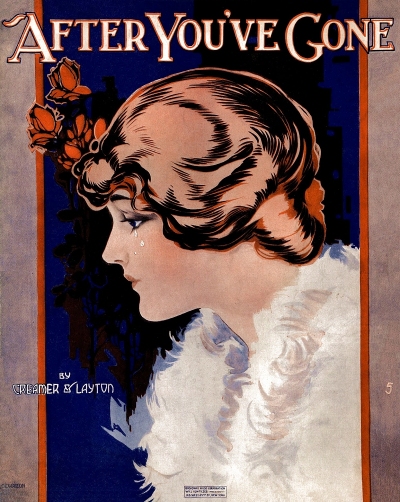
 Eralso Errol Walton (October 15, 1871? to May 20, 1954) | |
 Selected Covers (Hover to View) Selected Covers (Hover to View) | |
|
A Soldier's Rosary
After You've Gone Au Revoir, but Not Good Bye Soldier Boy Clap Your Hands My Baby I Want a Daddy Like You I'm Writing to You Sammy I'm Proud to Be the Sweetheart of a Soldier In the Valley of Roses with You Kirmanshah (I Know What ie Means to Be) Lonesome The Landlord Blues Little Girl | |
Eralso Errol Walton was known largely by his initials, E.E. Walton, during his professional life, which involved illustrating for a number of New York City firms. He was born in Cross Plains, Tennessee, anywhere from 1871 to 1877, depending on which account is the most credible. The earlier year is probable, given the lack of a World War I draft record, and that he was the oldest child of Professor of Humanities, John Martin Walton, LL. D. and Adelaine "Addie" Augusta Blackman, who were wed on November 27, 1870, in Williamson, Tennessee. It can be accepted that he might also have been born as late as 1875, but no later. Eralso's younger siblings included Newell Blackman (4/1879) and John M., Jr. (11/1885).

 While the family was not reliably located for the 1880 census, the 1900 enumeration taken in Goode, Alabama, which did not include Eralso, showed the senior John, now widowed, to be a teacher, likely at a local college.
While the family was not reliably located for the 1880 census, the 1900 enumeration taken in Goode, Alabama, which did not include Eralso, showed the senior John, now widowed, to be a teacher, likely at a local college.


As for Eralso, his whereabouts from the 1880s into the early 1900s were very hard to trace, even with his unique name. It is assumed he went to an art college in either Tennessee, Alabama, or perhaps New York, where he would end up. However, his identity was verified as distinct from a man using the name Eralso Walton during this period, who was sought throughout the 1890s and caught around 1899 after bilking several people in fake land deals and other securities crimes. This may well be one of the reasons he used his initials (common for artists) instead of his name in his work. Starting at some point around 1910, possibly before, he became a lithographer and engraver in New York City, working for advertising firms and providing images for books and magazines. The 1915 and 1918/1919 Trow's Copartnership and Corporation Directory for New York show him as co-owner of the Advertising Art and Engraving Company, along with William J. Miller.
The bulk of Walton's sheet music covers were created during World War I and shortly after, a time in which sending the right message with the right cover image was essential to keep up morale and, of course, sell music to commemorate the struggle of the brave boys overseas. His artwork skewed toward simplistic realism with the use of two or three colors, an economy partly dictated by the times, in concert with shrinking the size of sheet music covers as well as the music within. Walton did very few caricatures into the early 1920s, focusing more on the fine art aspect. Some of his covers are more about design than image, as they forecast the trend of the 1920s and later of including celebrity photographs rather than an image reflective of the lyrics. His last known sheet music covers were in the late 1920s. It should be noted here, also, that no discernible relationship between Eralso and the "Walton Process" used to print sheet music in Chicago was discovered, thus the name is likely coincidence.
Eralso's personal life was harder to decode, but there were a few clues. From the mid-1910s into the early 1920s he cohabitated with a woman known as Alice G. Walton, confirmed by the 1920 census taken in Manhattan, New York, and a later legal finding. The 1922 New York City directory showed him now as running the Walton Art Studio at 11½ 26th Street in Manhattan. Walton was separated from Alice by the mid-1920s, with no evidence of the couple having married or had children. He was married to Katherine Isabel Reynolds on July 12, 1926. After her death in late 1937, Katherine's sister filed suit against her will, of which Eralso was executor, claiming that his relationship to Alice G. should have been considered a common-law marriage (seven or more years at that time), and that he had therefore committed bigamy when he married Katherine. After months of deliberation, a November 5, 1938, finding showed that no evidence of marriage had been found for Eralso and Alice, and that an attempt to anul the relationship was declared invalid because of the lack of marriage evidence.
While Walton somehow evaded the 125 New York and 1930 and 1940 Federal enumerations, a 1939 notice showed him granting some land in Delaware to one Ella R. Ocks, the relationship being unknown. In 1942, he curiously registered for the World War II draft, citing his year of birth as 1886, some 14 years off from his likely actual age of 69, which explains his status as retired. Even more curious, he listed Alice Walton living at 230 Park Avenue, New York, as his point of contact, suggesting that the relationship had either come back in some capacity, or never fully ended. The 1950 census showed him living in New York city, but now widowed and unable to work. His listed age of 78 actually suggested an 1871 birth. Eralso died 4 years later in the spring of 1954, and was interred at the Fresh Pond Crematory and Columbarium in Middle Village, Queens, New York. His sheet music covers remain collectible into the 21st century both in online libraries and sheet music sales sites.